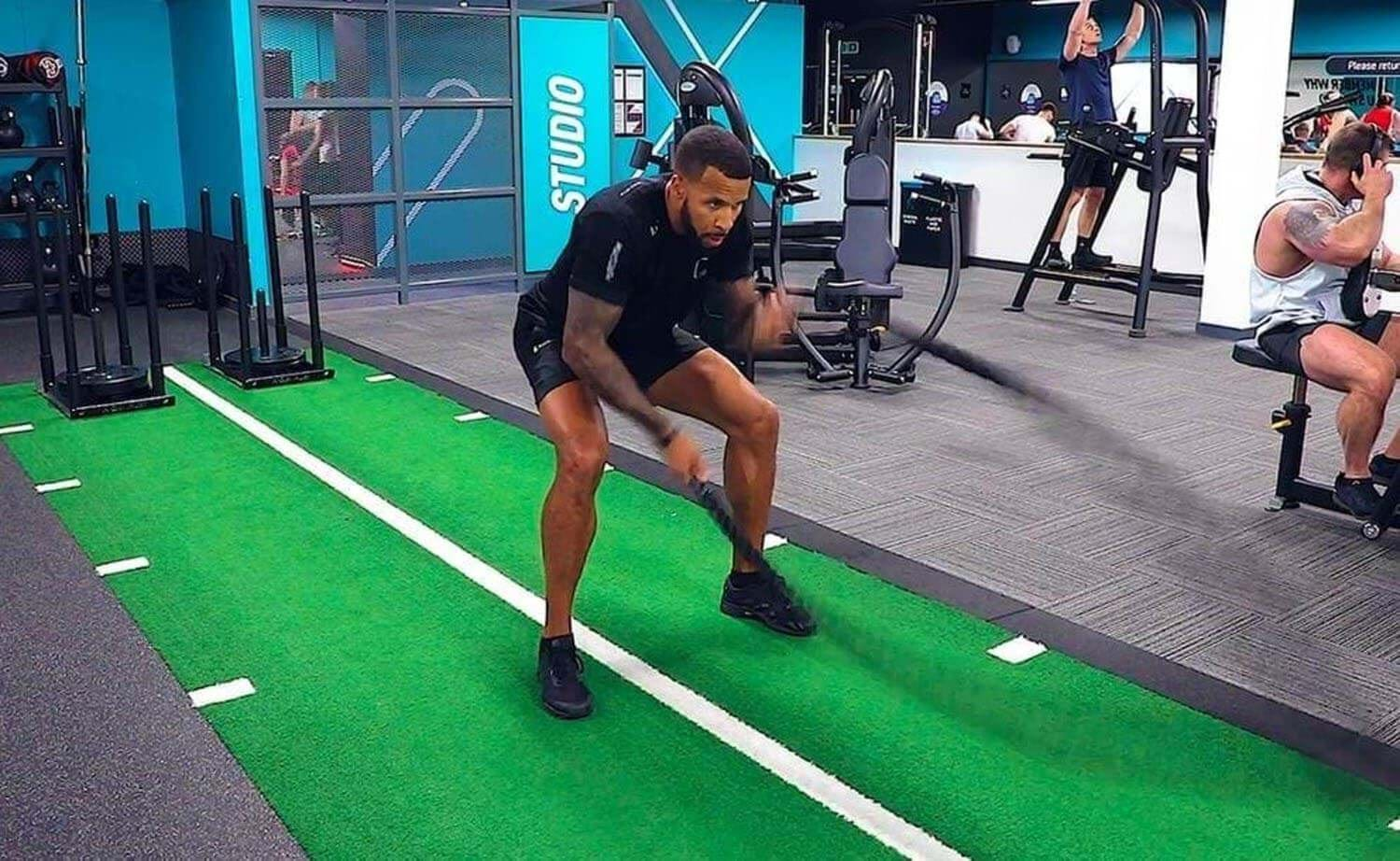The Best Gym Cutting Workout Plans

Are you ready to get shredded and lean, dropping body fat while maintaining muscle? If so, you've come to the right place, because today we're talking about the best workout plans for cutting.
Cutting is a challenging process that requires a combination of proper nutrition, consistent exercise, and discipline. But fear not, Hannah Kerridge, one of our personal trainers, is here to help you understand more and find the best cutting workout plan for you.
So, if you're ready to sweat it out, burn some calories, and achieve a leaner physique, keep reading because Hannah has some great tips and exercises to share with you.
WHAT IS CUTTING?
You may have heard the words ["bulking" and "cutting"][1] talked about in the fitness world, but what actually is "cutting"?
Cutting is the process of losing body fat while trying to maintain muscle mass. It's a form of dieting where the focus is on losing only fat, ensuring muscle mass is preserved to create a lean, toned appearance.
There are different types of cuts people do; for example, bodybuilders who are planning to compete in a show typically do quite an extreme cut, whereas someone who just wants to lose a few pounds will not have to be as strict.
A cut will usually last for 8-16 weeks depending on the overall goal and individual. I usually set my clients 12 weeks, as this allows for a slower cut that is more realistic and minimizes strength loss.
DIET & CUTTING
It's important to remember that regardless of anything else, food is fuel and should still be consumed regardless of whether you are in a cut or not. While you need to be in a calorie deficit in order to successfully cut, this doesn't need to be carried out to extremes or in a way that affects how you energize your body.
EXERCISE & CUTTING
It's important to exercise during a cut so you can maintain as much strength and muscle mass as possible. Focusing on weightlifting instead of cardio will help to prevent muscle loss during your cut and can even help to build muscle mass!
Eating enough protein will also help to preserve and build muscle mass during a cut, as it provides your muscles with the necessary building blocks to repair and rebuild themselves. Aim to consume at least one gram of protein per pound of body weight.
Working out breaks down the muscles, and eating enough protein throughout your cutting stage provides your muscles with the necessary building blocks to repair and rebuild themselves. Without adequate protein on a cut, the body can break down muscle instead of fat.
TIPS AND ADVICE FOR CUTTING
If you're interested in starting a cut, here are some tips to ensure it's successful.
1. Have a goal
Setting goals makes it easier to stick to a cut as you are working towards something tangible. Whether it's fitting into an old pair of jeans, losing an inch before a big occasion, or feeling more comfortable in your body, know what you're aiming for before you start.
2. Set a timeframe
You can't stay in a calorie deficit forever. Even if you have a lot of weight to lose, I wouldn't recommend cutting for more than three months at a time without a break, as you'll see motivation and adherence decline. Being in a calorie deficit for long periods can also mean you're not getting enough nutrients over time.
Setting a timeline and end date can help you to stay on track with your cut. After, you can choose to maintain your weight or [build muscle][2] (the 'bulk' part of bulking and cutting), and if you still have weight to lose you can cut again after a break.
3. Slowly reduce your calories
People often make the mistake of drastically reducing their calories to lose weight as quickly as possible, however this often backfires. An extreme calorie deficit is harder to stick to, and when weight loss plateaus there isn't any room to cut more calories.
Unless you have an event coming up, start by dropping your calories around 200 -- 300 below your maintenance calories (known as TDEE or total daily energy expenditure), increasing this up to 400 -- 500 calories if needed.
4. Move more
A simple way to increase your TDEE and help to create a bigger calorie deficit is to move more, outside of working out. Known as NEAT (non-exercise activity thermogenesis), adding an extra 1,000 steps a day, taking the stairs instead of the lift, and even pacing while on the phone, can all add up!
5. Train with intensity
Maximize the benefits of your workouts by training with intensity! To build muscle, you want to train close to fatigue, which means the last few reps should be a challenge! The more you put in, the more you get out.
6. Include both cardio and strength training
Cardio is a key element to cutting as it burns a significant number of calories. If you burn an extra 200 calories a day, four times a week, that's 800 calories helping towards a deficit. Just make sure that you're not putting it all in your workouts, then staying sedentary the rest of the day as this will counteract the calories burned.
Strength training exercises are crucial to building and preserving muscle mass, helping to create a toned appearance and increasing your metabolism.
7. Remember everyone is different
What works for one person may not work for others. Find a system that works for you and go with it!
EXAMPLE CUTTING WORKOUT PLAN
Here are three examples of full body strength training workouts you can do on a cut that will help burn calories and build muscle. You can do all three workouts across the week, or pick your favorite and repeat this.
Cutting Workout 1
- Barbell Squats - 3 sets of 8-12 reps
- Romanian Deadlift - 3 sets of 8-10 reps
- Pull Ups - 2 sets of 8-12 reps
- Incline Chest Press - 2 sets of 10-15 reps
- Lateral Raises - 2 sets of 15 reps
- Plank - 2 sets of 30-45 seconds
- Crunches - 2 sets of 30 seconds
Cutting Workout 2
- Barbell Bench Press - 3 sets of 8-12 reps
- Chest Fly - 3 sets of 12 reps
- DB or Barbell Lunges - 3 sets of 10 reps on each leg
- Barbell Overhead Press - 2 sets of 8-10 reps
- Tricep Push Downs - 3 sets of 15 reps
- Bicep Curls - 2 sets of 12 reps
- Bird Dog - 2 sets of 12 reps
- V-ups - 2 sets of 12 reps
Cutting Workout 3
- Hip Thrusts - 3 sets of 10-12 reps
- Leg Press - 3 sets of 10-12 reps
- DB Single Arm Bent Over Row: 2 sets of 12 reps
- Flat Dumbbell Chest Press - 2 sets of 12 reps
- Front Raises - 2 sets of 15 reps
- Leg Extension: 3 sets of 15 reps
- Hamstring Curl: 2 sets of 12 reps
- Abductor: 3 sets of 12-15 reps
You can then add your cardio either at the end of these days or on separate days. LISS (low-intensity steady state) or HIIT (high-intensity interval) cardio can be used for your cardio and it comes down to personal preference on what one to use.
- Example LISS: 30-60 minute treadmill fast walk - incline moderate,
aiming for 60-75% max heart rate.
- Example HIIT: 1 min run (60-70% max Heart rate) followed by 20-second
sprint (90-95% max heart rate) - repeated 10 times.
Remember that in order to cut you MUST be in a calorie deficit. This does not mean starving yourself or restricting yourself from any foods. Be mindful of what you are eating and ensure you are having adequate protein, carbs and fat within your diet.
For more information on bulking and cutting, check out our article "A Beginner's Guide to Bulking and Cutting" [HERE][3] or "Bulking and Shredding What Is It and Is It For Me" [HERE][4]. Also, consider booking a session with a dedicated Personal Trainer at Pure Fitness - they're able to offer a wealth of advice for both fitness and nutrition.
[1]: https://purefitness.com/blogs/a-beginners-guide-to-bulking-and-cutting/
[2]: https://www.purefitness.com/blogs/the-best-gym-workout-plan-for-gaining-muscle/
[3]: https://purefitness.com/blogs/a-beginners-guide-to-bulking-and-cutting/
[4]: https://www.purefitness.com/blogs/bulking-and-shredding-what-is-it-and-is-it-for-me/


